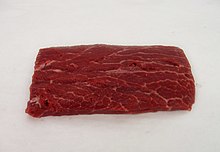90.222.157.32 (talk) ←Replaced content with 'XNOR gate (≡)' Tag: blanking |
ClueBot NG (talk | contribs) m Reverting possible vandalism by 90.222.157.32 to version by Hydrargyrum. False positive? Report it. Thanks, ClueBot NG. (816741) (Bot) |
||
| Line 1: | Line 1: | ||
{{beefbox |
|||
XNOR gate (≡) |
|||
|name=Beef Cuts |
|||
|image=BeefCutChuck.svg |
|||
|caption= |
|||
|beefcut=Chuck |
|||
|steaktype=Flat Iron Steak |
|||
|footnotes=(also known as: top blade roast,shoulder top blade roast, top boneless chuck, petite steak,<br />butler steak, lifter steak, book steak, chuck clod, lifter roast, and triangle roast) |
|||
}} |
|||
'''Flat iron steak''' is the American name for the cut known as "butlers' steak" in the UK and "oyster blade steak" in Australia and New Zealand. This cut of [[steak]] is from the [[shoulder]] of a beef animal.<ref name="NAMP">{{Cite web|url=http://www.beeffoodservice.com/recipecut.aspx?id=216|title=Beef Foodservice - Beef Chuck, Shoulder Clod, Top Blade Steak (Flat Iron)|publisher=Cattlemen's Beef Promotion And Research Board|accessdate=August 16, 2011}}</ref> The steak encompasses the [[infraspinatus]] muscles of beef, and one may see this displayed in some butcher shops and meat markets as a "top blade" roast. Steaks that are cross cut from this muscle are called [[blade steak|top blade steaks]] or patio steaks. As a whole cut of meat, it usually weighs around two to three pounds; it is located adjacent to the heart of the shoulder clod, under the seven or paddle bone (shoulder blade or scapula). The entire top blade usually yields four steaks between eight and 12 ounces each. Flat iron steaks usually have a significant amount of [[Marbled meat|marbling]]. Anatomically, the muscle forms the dorsal part of the rotator cuff of the steer. This cut is anatomically distinct from the [[shoulder tender]], which lies directly below it and is the [[teres major]]. |
|||
[[Image:flatiron steak.jpg|thumb|left|Raw flat iron steak]] |
|||
Restaurants, particularly upscale, have recently begun serving flat iron steaks on their menus. Especially popular are flat irons from [[Wagyu beef]], as a way for chefs to offer more affordable and profitable dishes featuring [[Wagyū]] or [[Kobe beef]].<ref>{{Cite web|url=http://www.cabnr.unr.edu/wpm/ProductDetails.aspx?ProductID=57|title=Flat Iron Steak - Wolf Pack Meats|publisher=University of Nevada, Reno|accessdate=August 16, 2011}}</ref> To make it more marketable, the steak, which has the fascia dividing the infraspinatus within it, has, in recent years, been cut as two flatter steaks, each corresponding to one muscle, with the tough fascia removed. |
|||
In the North American Meat Processor (NAMP) meat buyers guide, it is item #1114D Beef Shoulder, Top Blade Steak. The NAMP lists it as the second most tender cut, after the tenderloin, and followed (in order) by the top sirloin center cut, the ribeye and strip steak center cut, and finally beef shoulder, arm.<ref name="NAMP"/> |
|||
{{-}} |
|||
==External links== |
|||
* {{Cite web|url=http://news.ufl.edu/2007/11/28/flat-iron-steak/|title=Article on Flat Iron steak's growing popularity from the University of Florida}} |
|||
* {{Cite web|url=http://ard.unl.edu/c/document_library/get_file?folderId=1161330&name=DLFE-14357.pdf|title=Agricultural Research Division - 116th Annual Report|publisher=University of Nebraska-Lincoln|page=6|format=pdf}} |
|||
==References== |
|||
{{reflist}} |
|||
[[Category:Cuts of beef]] |
|||
[[sv:Luffarbiff]] |
|||
Revision as of 14:50, 15 January 2012
| File:BeefCutChuck.svg |
Flat iron steak is the American name for the cut known as "butlers' steak" in the UK and "oyster blade steak" in Australia and New Zealand. This cut of steak is from the shoulder of a beef animal.[1] The steak encompasses the infraspinatus muscles of beef, and one may see this displayed in some butcher shops and meat markets as a "top blade" roast. Steaks that are cross cut from this muscle are called top blade steaks or patio steaks. As a whole cut of meat, it usually weighs around two to three pounds; it is located adjacent to the heart of the shoulder clod, under the seven or paddle bone (shoulder blade or scapula). The entire top blade usually yields four steaks between eight and 12 ounces each. Flat iron steaks usually have a significant amount of marbling. Anatomically, the muscle forms the dorsal part of the rotator cuff of the steer. This cut is anatomically distinct from the shoulder tender, which lies directly below it and is the teres major.

Restaurants, particularly upscale, have recently begun serving flat iron steaks on their menus. Especially popular are flat irons from Wagyu beef, as a way for chefs to offer more affordable and profitable dishes featuring Wagyū or Kobe beef.[2] To make it more marketable, the steak, which has the fascia dividing the infraspinatus within it, has, in recent years, been cut as two flatter steaks, each corresponding to one muscle, with the tough fascia removed.
In the North American Meat Processor (NAMP) meat buyers guide, it is item #1114D Beef Shoulder, Top Blade Steak. The NAMP lists it as the second most tender cut, after the tenderloin, and followed (in order) by the top sirloin center cut, the ribeye and strip steak center cut, and finally beef shoulder, arm.[1]
External links
- "Article on Flat Iron steak's growing popularity from the University of Florida".
- "Agricultural Research Division - 116th Annual Report" (pdf). University of Nebraska-Lincoln. p. 6.
References
- ^ a b "Beef Foodservice - Beef Chuck, Shoulder Clod, Top Blade Steak (Flat Iron)". Cattlemen's Beef Promotion And Research Board. Retrieved August 16, 2011.
- ^ "Flat Iron Steak - Wolf Pack Meats". University of Nevada, Reno. Retrieved August 16, 2011.